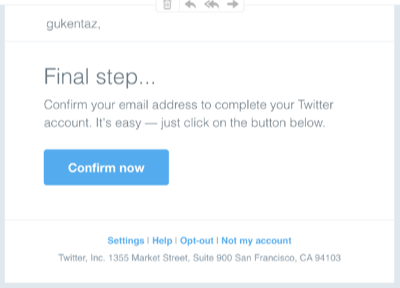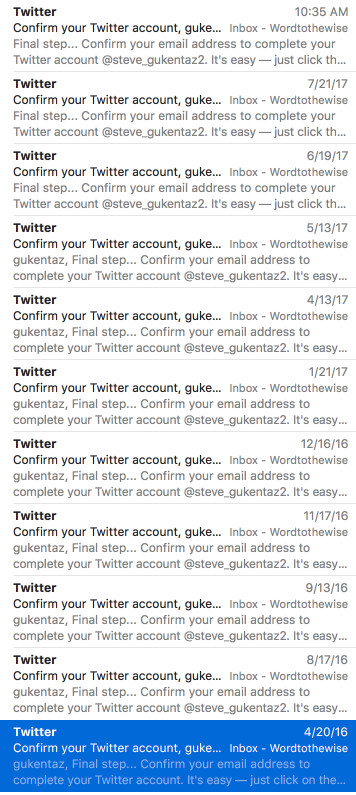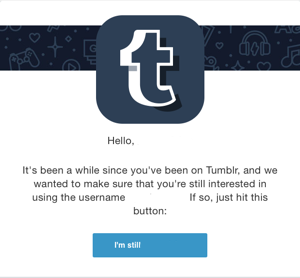Confirmation
Maybe they're just not that into you?
In April of last year I created a new twitter account. I can’t remember exactly why, but it was a throwaway created to look at some aspect of how twitter interacts with new accounts.
As part of the account creation process I gave Twitter an email address. They sent me a confirmation message right away:
I didn’t click the button.
Four months later they sent me another confirmation email. I didn’t click the button.
It’s now sixteen months later. Nobody has logged in to or interacted with that twitter account since the day it was created. Twitter are sending me confirmation messages for that account about once a month.
They’re doing quite a lot of things right – they have not just an “Opt-out” link but also a “Not my account” link, which is great!
But after sixteen months of not returning your messages, maybe they’re just not that in to you?
Tumblr Confirming Usernames
Today I received an email from Tumblr asking to confirm I still wanted the username I have there. I’ve not really been using Tumblr, I contributed a few things to the now-defunct Box of Meat, but I don’t really post there much.
I think this kind of engagement is great. Confirming user names will do a whole lot to allow Tumblr to release some claimed but unused names back into the pool. It will also actually help their deliverability and their engagement. If people do want to keep their tumblr names, then they have to click on the message. This means more clicks and better engagement and an overall reputation boost for Tumblr mail.
Tor cleans up their lists
Recently I got an email from Tor. Apparently they’re watching their opens and clicks and they noticed I hadn’t loaded any images recently.
Read MoreA new twist on confirmation
I got multiple copies of a request to “confirm my email address” recently. What’s interesting is the text surrounding the confirmation request.
Read MoreConfirmation is too hard…
One of the biggest arguments against confirmation is that it’s too hard and that there is too much drop off from subscribers. In other words, recipients don’t want to confirm because it’s too much work on their part.
I don’t actually think it’s too much work for recipients. In fact, when a sender has something the recipient wants then they will confirm.
A couple years ago I was troubleshooting a problem. One of my client’s customer was seeing a huge percentage of 550 errors and I was tasked with finding out what they were doing. The first step was identifying the source of the email addresses. Turns out the customer was a Facebook app developer and all the addresses (so he told me) were from users who had installed his apps on Facebook. I did my own tests and couldn’t install any applications without confirming my email address.
Every Facebook user that has installed an application has clicked on an email to confirm they can receive email at the address they supplied Facebook. There are over 1 billion users on Facebook.
Clicking a link isn’t too hard for people who want your content. I hear naysayers who talk about “too hard” and “too much drop off” but what they’re really saying is “what I’m doing isn’t compelling enough for users to go find the confirmation email.”
This isn’t to say everyone who has a high drop off of confirmations is sending poor content. There are some senders that have a lot of fake, poor or otherwise fraudulent addresses entered into their forms. In many cases this is the driving factor for them using COI: to stop people from using their email to harass third parties. Using COI in these cases is a matter of self protection. If they didn’t use COI, they’d have a lot of complaints, traps and delivery problems.
The next time you hear confirmation is too hard, remember that over 1 billion people, including grandparents and the technologically challenged, managed to click that link to confirm their Facebook account. Sure, they wanted what Facebook was offering, but that just tells us that if they want it bad enough they’ll figure out how to confirm.
HT: Spamresource
Don't leave that money sitting there
The idea of confirming permission to send mail to an email address gets a lot of bad press among many marketers. It seems that every few weeks some new person decides that they’re going to write an article or a whitepaper or a blog and destroy the idea behind confirming an email address. And, of course, that triggers a bunch of people to publish rebuttal articles and blog posts.
I’m probably the first to admit that confirmed opt-in isn’t the solution to all your delivery problems. There are situations where it’s a good idea, there are times when it’s not. There are situations where you absolutely need that extra step involved and there are times when that extra step is just superfluous.
But whether a sender uses confirmed opt in or not they must do something to confirm that the email address actually belongs to their customer. It’s so easy to have data errors in email addresses that there needs to be some sort of error correction process involved.
Senders that don’t do this are leaving money on the table. They’re not taking that extra step to make sure the data they were given is correct. They don’t make any effort to draw a direct line between the email address entered into their web form or given to them at the register or used for a receipt, and their actual customer.
It does happen, it happens enough to make the non-tech press. Consumerist has multiple articles a month on some email address holder that can’t get a giant company to stop mailing them information about someone else’s account.
Just this week, the New Yorker published an article about a long abandoned gmail address that received over 4000 “legitimate” commercial and transactional emails.
Confirming addresses for transactional mail
A colleague was asking about confirming transactional mail today. It seems a couple of big retailers got SBLed today for sending receipts to spamtraps. I talked a few weeks ago about why it’s important to let people unsubscribe from transactional email, and many of those same things apply to confirming receipts.
Read MoreConfirmation Fails
Yesterday I talked about registration confirmations. Today I’m going to talk about a couple recent experiences with websites and their registration failures.
The first experience was with Yelp. One of my readers decided I needed a Yelp account and created one using my laura-questions email address. Yelp understands that people will be jerks and so sent me an email to confirm the account.
Confirming website registrations
Confirming email addresses during a website registration process is a good practice. It stops people from creating fake accounts, abusing resources and using that site as a mechanism for harassment. But simply sending out a confirmation mail is not sufficient to prevent problems, particularly when everything about the process assumes that unconfirmed registrations are actually valid and not problem accounts.
I’ve had a couple recent experiences with companies attempting to use email confirmation, but failing pretty miserably. In each case a website set up a process where a user could register an account on the site. Both sites required confirmation of the registration email addresses as part of the process. But in each case there were some major failures that result in non-customers getting email.
Tomorrow I’ll talk about those two specific cases. I’ll also provide specific suggestions on how not to fall into the same trap and actually send opt-in email.
Confirming addresses in the wild
A lot of marketers tell me “no sender confirms addresses” or “confirming addresses is too hard for the average subscriber.” I find both these arguments difficult to accept. Just today I subscribed to a mailing list that had a confirmation step. The subscription form was pretty simple.